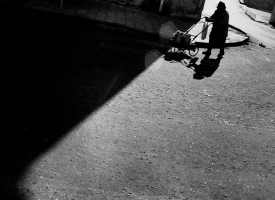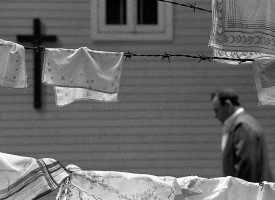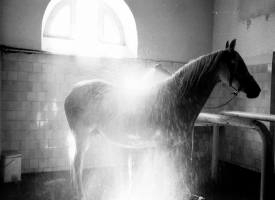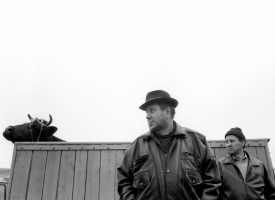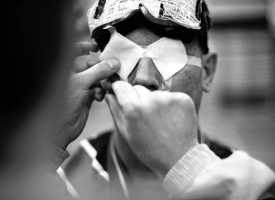ex oriente lux
Documenting forgotten world – Ex Oriente Lux.
As Europe is currently undergoing its most radical and daring transformation by accepting ten new countries to join European Union, few Euro-peans are nonetheless aware of what lies ahead. I bet relatively few outsiders know what Podlasie is, and to be honest I would not know about it myself had I been not born there. Ex Oriente Lux brings a comprehensive, although by no means complete picture of this region between Poland, Belarus, and Lithuania. The aim was to explore and record life as it happened everyday for the whole 2002, and per-haps to give a systematic account of the region just before it is seriously transformed because of Pol-and’s incoming EU membership. The present text seeks to provide a short introduction, and some sort of context for the photographs, although I am posi-tive they perfectly speak for themselves.
Poland is by no means a homogenous country. Traveling from Poland’s Western to Eastern border, one can easily spot the differences which go back to the historical events of the 18th century (Poland was under partition of Russia, Prussia, and Austria-Hun-gary for over 120 years). The northeastern region, known as Podlasie, bears heavy marks of Russian influence. Significantly orthodox (contrary to the over-whelming Catholicism of the country), and multi-ethnic, Podlasie differs in many respects and can be better compared not with its adjacent western regions, some of which were either Prussian or Austrian, but with the eastern neighbors – today Belarus and Lithuania. Connected by Europe’s lar-gest primeval forest, but divided by political bound-aries, to a great extent three parts of three different countries constitute a true ‘small motherland’ com-munity glued by common beliefs, religion, and me-ntality.
Podlasie is also unique in its extraordinary ecological qualities. Termed ‘Poland’s green lungs’, it stands out among other Polish regions for its pic-turesque landscapes, clean air and nature. Further-more, nowhere are the bonds between a man and the environment stronger, and preserved in peo-ple’s religious superstitions. Add to this a unique ethnical blend – more than ten ethnic or religious minorities coexisting peacefully, together accounting for over 20% of the region’s population – and the emerging overall picture is that of a fascinating eth-nic melting pot subsumed in some of the Europe’s most breathtaking sceneries, on the verge of major political reshaping. It waited to be thoroughly docu-mented
Ex Oriente Lux is by large the largest and most ambitious photo documentary project ever carried out in the history of Polish photography. With the 12 photographers exploring “the unknown, and the fa-miliar, distant, and near”, as Dan Eldon once rema-rked, of the Podlasie region and parts of Belarus and Lithuania for the entire year, it can be justly se-en next to the breakthrough actions in social docu-mentary photography – The Family of Man (1955), and Farm Security Administration (1935).
In reflecting on a photo project of such a vast scope and diversity, it is almost unfeasible to come up with any all-encompassing generalizations. Each of the twelve participating photographers brought his (oddly enough, no women were involved) own experiences, and his own way of seeing. At the sa-me time, the editors decided to refrain from impo-sing any pre-shooting constraints on the participa-nts with regards to content or style, so the final out-put remains a wonderfully diverse corpus of pictures bound together only by the settings in which they had been taken. In what follows, however, I will try to at least signal several tendencies and qualities that struck me as characteristic and worthy paying atten-tion to.
For those well familiar with the region, EOL photographs will most likely come as surprise. To say the least, the pictures are not a systematic doc-umentary record of social conditions in Podlasie, nor are they an objective look at various religious or quasi-religious practices. Having lived in the region’s biggest town for over 15 years, I have never encountered so many people of different cultures – here represented by young Jews visiting the memo-rial in Tykocin or by various communities meeting at the festival in Mielnik. Not having seen the pictures, I would not believe in some of the pastimes still pra-cticed in the countryside – like having a vodka party in the middle of primeval forest or putting on empty plastic bottles for a bizarre ‘build the strangest swimming utility’ competition in Augustow.
Although some of the issues broached in these pictures are quite serious, the overall tone seems to be that of detachment, bitter or ironical comment, rather than emotional commitment. This particular features marks EOL’s greatest departure from the photographic style centered on humanity’s great moments outlined in “The Family of Man” and takes it closer to photographic approaches which focus on banality of everyday human existence. Take a look at ordinary old people passing by, or meeting on the street for a chat. Or kids bathing, musicians on the bus (Rozany), an old man explaining something to two young girls (Bialystok) – it’s the world, and the region as we know it. Then there is a number of photographs taken in Augustow – one of the Poland’s most popular tourist resorts. Shot with dry humor and penetrating irony, images from Augos-tow (but not only these, also those from Kudirkos or Korycin) invoke perspective similar to Martin Parr’s work in Brighton. Indeed, some of the pictures could have easily made it to the boring postcards book.
Another side of the same coin is the series of photo-graphs featuring people at work. However, profes-sions depicted in EOL are vanishing, like old relics from the past. In the age of improving technology, and frequently of ridiculous bureaucratic regula-tions, various positions are systematically reduced. On the other hand, local people skilled in handcraft or those whose job had close links with nature have always been held in high esteem here. The lonely fisherman collecting cane at Narew River, a man regulating water at Siemianowka reservoir, another man sowing by hand in Wasilkowo are just few examples of extraordinarily skilled individuals doing jobs long abandoned and forgotten elsewhere.
One of the prevailing themes in EOL is the region’s artistic output. Contrary to widely spread stereo-types, EOL depicts Podlasie as a place abundant with various cultural and artistic events. It seems music plays special role here, often seen as medium between man and nature (a folk tales view, some of which are still told as part of ‘cultural heritage’ education). More pragmatically, live music provides plenty of entertainment for various social or official occasions. Finally, an old tradition of police-men and firefighters orchestras is appreciated during annual orchestras’ competition (see pictures from Tykocin or Zbucz). On top of all this, Podlasie is known for its annual festival of Orthodox church music in Hajnowka, also featured in EOL. The festival attracts performing groups from all over the world and takes place in an impressive Orthodox church of Hajnowka. The region’s cultural events are by no means limited to religion. In fact, the most ambitious art festival – “Contemporary Art Week” in Bialystok – has nothing to do with the sacred, un-less it desecrates it. Other significant events include Basowiszcza – the festival of Belarusian rock music taking place in Grodek, Poland, and officially banned in Belarus as subversive.
When looking at the official survey statistics, Poland is an overwhelmingly religious country. Some 98% of the people declare faith in God, although only one third attends Sunday mass on a regular basis. Ne-edless to say, the data above concern Polish Catho-lics. Once again, Podlasie differs. Region’s reli-gious profile includes Orthodox Christians (whose vast majority lives in the region), Tatars, Jews, and Muslims. EOL clearly reflects this diversity and if I were to pick up the single most significant subject matter covered by the photographers, it would have to be precisely religion. The importance of religion in EOL becomes self-evident in many ways. The do-minant down-to-earth framework gives place to a more contemplative and object-respectful approach which yields impressive results. The photographs featuring annual pilgrimage to Garbarka (a holy mountain according to the Orthodox tradition) or a solitary prayer in Bohoniki count among the most powerful images of the whole project – their stun-ning visual quality matches the intensity of emotions and religious beliefs depicted. When religion frequ-ently remains only an empty category in the survey, and has no everyday meaning to those who declare themselves Christians, EOL goes against the cur-rent to show the beauty of religious experience, be it during a procession or by a close-up shot of an altar boy (Punsk).
Finally, one comment of sociological nature. Although in terms of number of pictures EOL might give an impression of Podlasie as predominantly rural region, it is not necessarily the case from other points of view. Urban centers continue to attract young people from the entire region (hence the demographical gap in the countryside, with children and elderly people only), and develop their own ways of life, with numerous peer communities (bike raiders, to mention one from EOL), vivid media market, and the characteristic (albeit terrible) archi-tecture from ‘the past period’, as Poles like to say. Urban and rural coexist, rather than compete, and the contrast between the two surely adds to the re-gion’s dynamics.
Urban and rural, then, sacred and secular, professional and common-sense, serious and humoristic – these are the opposites which lie at the core of EOL as of 2002. The photographs have alre-ady become an important statement about the region, the statement I am sure will be more and more valuable as the region undergoes thorough transformation in the next several years.
Łukasz Abramowicz

PLAN YOUR VISIT
Opening times:
Thuesday – Sunday
10:00-18:00
Last admission
to exhibition is at:
17.30
